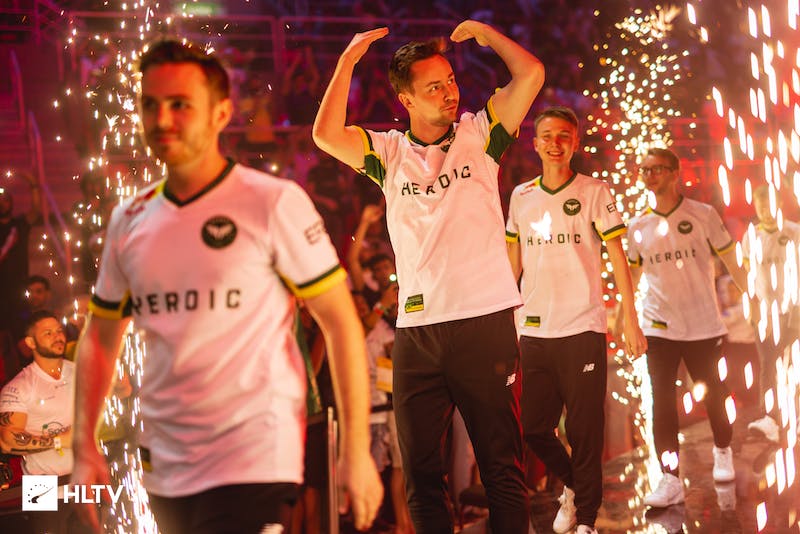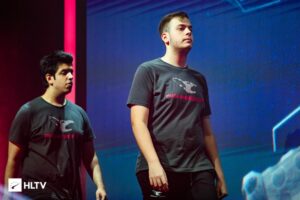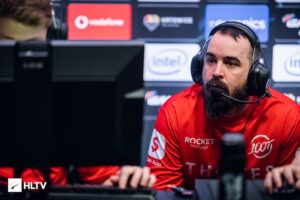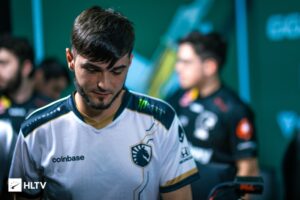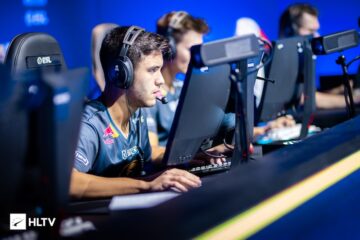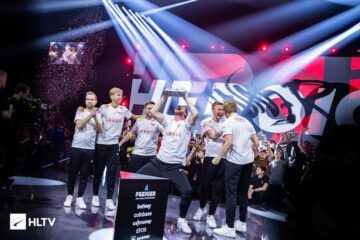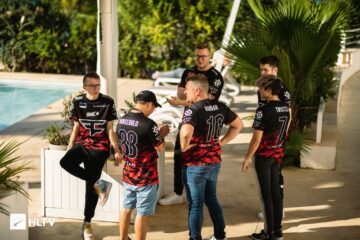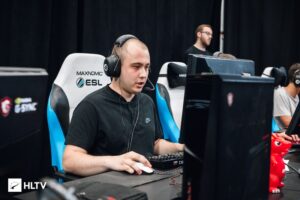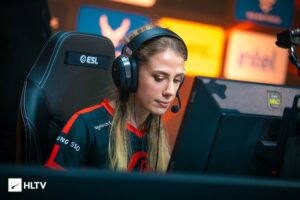Dust2 has been removed from the active map pool to make room for Anubis, an unwelcome surprise to those that had made it their home. Teams that picked it fairly often at BLAST Premier Fall Finals, like G2, Fluxo, Natus Vincere and OG, had their final chance on the map. BIG and Vitality, watching from home, did not have that luxury. From BLAST’s World Final onwards, Counter-Strike’s most iconic and old-school competitive map will be retired for the second time.
However, only a few teams have truly relied on Dust2 for the past few years. It’s played a reasonable amount, ranking fourth out of the seven maps in the last six months, but its removal does not have the shattering impact the removal of Mirage or Inferno would. There are, perhaps, more teams who benefit from this change than those who lose out.
Heroic are the highest-ranked team that bans Dust2
Chief among those waiting in the wings are those who permanently ban the map. Of the 40 teams to have played a LAN match while in the top thirty in the last six months, 10 teams have played Dust2 in less than 4% of their maps. These include Heroic, MOUZ, FURIA, fnatic and Ninjas in Pyjamas, all teams who hope to benefit the most from this change.
What’s more is that there are multiple ways these sides can benefit from its removal. They can pivot to a seven-map pool, temporarily, using their permaban to cover off their opponent’s strengths and take their chances on the even playing field of a completely fresh map. There’s also the safe option of just swapping their permaban to Anubis and continuing to strengthen the six maps they are already familiar with. Meanwhile, teams who liked Dust2 are forced into getting up to speed on Anubis, and fast.
So, just how seismic will this shift be? The removal of Cobblestone in April 2018 coincided with the rise of Astralis, who became the greatest team of all-time. Heroic and company will be salivating at the chance to do the same, but how realistic is that? Let’s take a look at the teams that have had their permabans removed in the past and see where it leaves our modern teams.
First up, we can see that more top teams ban Dust2 than any of the previous maps that got removed. Six current top 30 teams have it as their permaban (defined as any map that has less than a 4% share of their map pool) at the time of its removal compared to four for Train in 2021 and six for Cache in 2019.
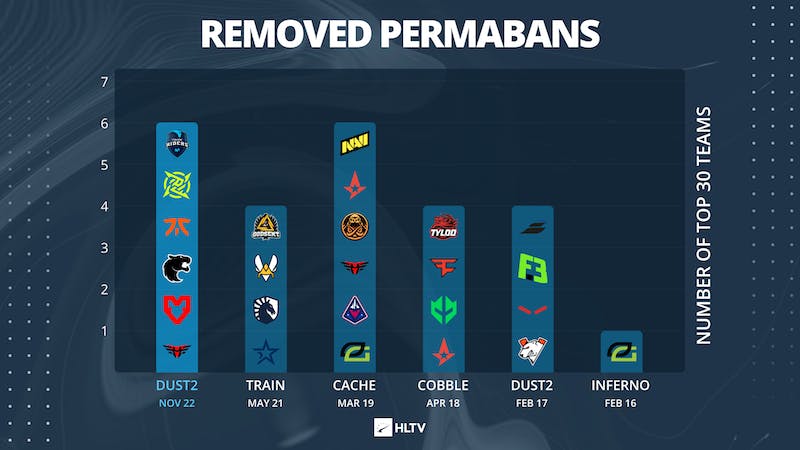
The six teams here that ban Dust2 will have to share out the benefit they receive compared to Astralis in 2018, who were one of only two top teams to ban Cobblestone when it was removed. Therefore, they and FaZe had more of a leg-up over their opposition than the benefactors from Dust2’s removal will receive because the advantage is mitigated when they face someone who also used to ban the map that was removed.
But how much of the Astralis narrative around the removal of Cobblestone is myth? There is no doubt that it helped the Danes, who wielded a seven-map pool for a short time before banning Cache — incidentally, the next map to be removed — and then Mirage. Valve left all of their best maps in the pool during their era.
For the other teams that had their permabans removed, however, there are less tangible examples of an active map pool change supercharging their success. In fact, of the thirteen teams that were still in the top 30 six months after their permaban was removed, only six teams maintained or improved their position.
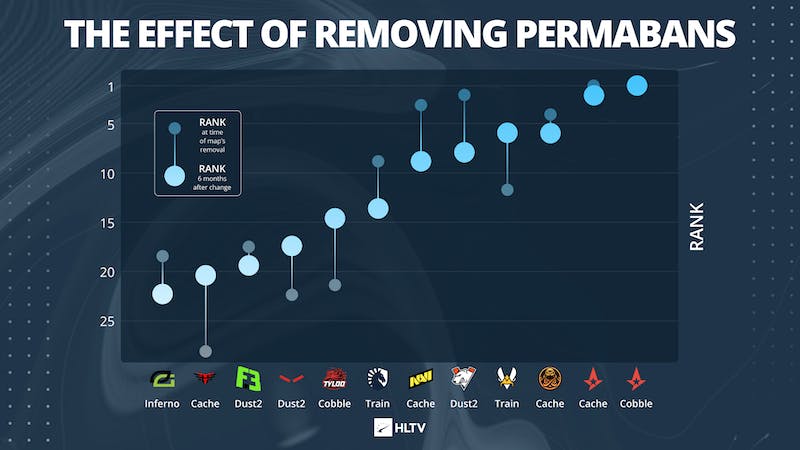
One powerful advantage to having your permaban removed is that it allows you to pivot your permaban to a popular map. Take ENCE, who ban Inferno now. By vetoing Inferno, ENCE can push their opponents away from a map the vast majority of the scene rely on in their pool. It also helped that ENCE hit the ground running on the less popular Ancient, winning it 21 times (and losing 16) between its addition and Lotan “Spinx” Giladi‘s departure.
Vitality also benefited, but they took the safe approach of swapping their Train permaban for Ancient. While much of the scene was focussing on the new map, Vitality hammered down their existing six-map pool to become the second-best team in the world by the end of the year, capping it off with a win at IEM Winter.
There is little sense in speculating which of these two approaches teams that banned Dust2 will take. There is opportunity for Ninjas in Pyjamas to ban Mirage given their form on it lately, and adopt Anubis in it’s stead. Ninjas in Pyjamas are an interesting talking point because they bring into consideration the other big factor here: Rather than talking about who benefits from Dust2’s removal, who benefits from Anubis’ addition?
The Ninjas are our first port of call precisely because they drove the meta on Ancient the last time the map pool changed. That time, they did so out of choice, developing their Ancient instead of making it their ban. In fact, they even changed their permaban during this period from Vertigo to Dust2, doubling down on becoming experts in the newer, trickier maps. When we look at the other teams that found early success on Ancient, we could get a clue at who will bring the best form to Anubis early on.
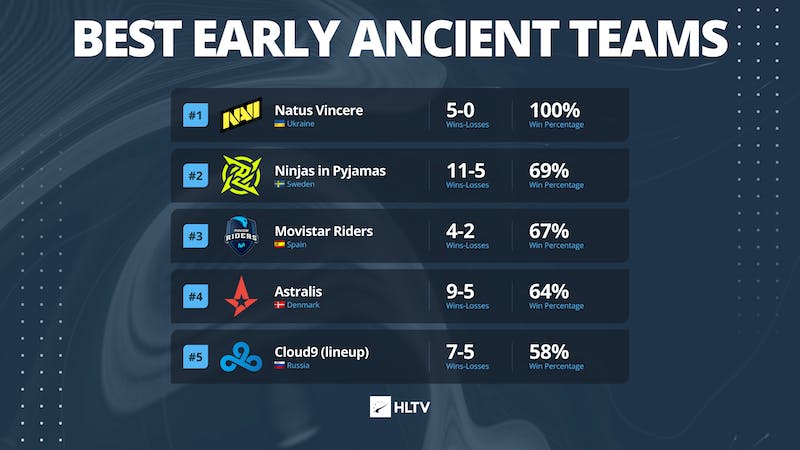
Natus Vincere and Cloud9 boast the highest round-win percentage on the map, but largely because they were the best teams in the world at the time. The teams that stood out on the map tactically were the likes of Astralis, Movistar Riders, and Ninjas in Pyjamas. Astralis defined the T-sides on the map with Kristian “k0nfig” Wienecke bursting out of middle and lurking around red, but that approach eventually fizzled out as slower defaults took over.
It is for these types of teams, those hovering around the bottom half of the top fifteen, that a new map represents such a good opportunity. It is a level playing field, something to spend all day theorycrafting and perfecting in order to grab a 1:0 lead in a best-of-three. With a long break ahead, there is plenty of time to try and garner that advantage before the 2023 season gets underway.
For the teams higher up in the ranking, Anubis represents just as interesting a choice. Do they ban the new map to avoid the high-variance nature of something that will develop at breakneck speed, or do they take advantage of their superior skill to brute force wins on a map that nobody will be particularly good at? It’s an ideological discussion, one that will be interesting to see play out and tell us quite a lot about the mindset within each team.
On paper, the teams with the best IGLs, coaches, and backroom staff, should become the best on Anubis fastest. Outsiders are one such squad and they have only had a mediocre Dust2 this year, so they should benefit. Heroic may switch to a seven-map pool. Finn “karrigan” Andersen and FaZe also had some issues on Dust2, and have no qualms taking risks in vetoes — something that should not change despite their loss to Bad News Eagles on Vertigo at IEM Rio.
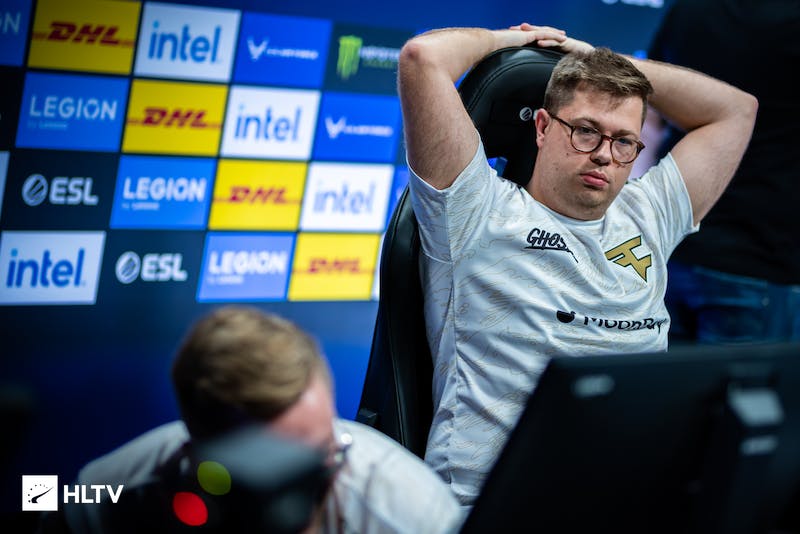
karrigan has made a name for himself with his bold vetos — will Anubis be part of that in the future?
Natus Vincere will be confident they can find a tactical edge on a new map, and with their second most-picked map of Dust2 removed, they might need to. Vitality also liked Dust2 quite a lot, but there is a chance that they move away from banning Ancient, a map Danny “zonic” Sørensen, Peter “dupreeh” Rasmussen and Emil “Magisk” Reif know quite well, rather than putting too much time into Anubis. The safe option worked out well for Vitality in 2021 when Ancient was added, so it would not be surprising for them to opt for the same path once more.
This leads us to the other side of the coin: Who will be hurt the most by this change to the map pool? fnatic‘s fall from power in 2016 was partly due to general burnout and Olof “olofmeister” Kajbjer‘s injury, but the removal of Inferno around the same time, their most played map, surely didn’t help.
Several teams are at risk of the same fate, though fewer than other maps given that Dust2 is hard to find wins on consistently, and thus rarely picked. One team that broke the mold was BIG, who were one of the only teams to pick it time after time, but even they had a losing record, with 11 losses to 8 wins on the map this year. Instead, the teams that found success were, in general, those that were elite across most maps.
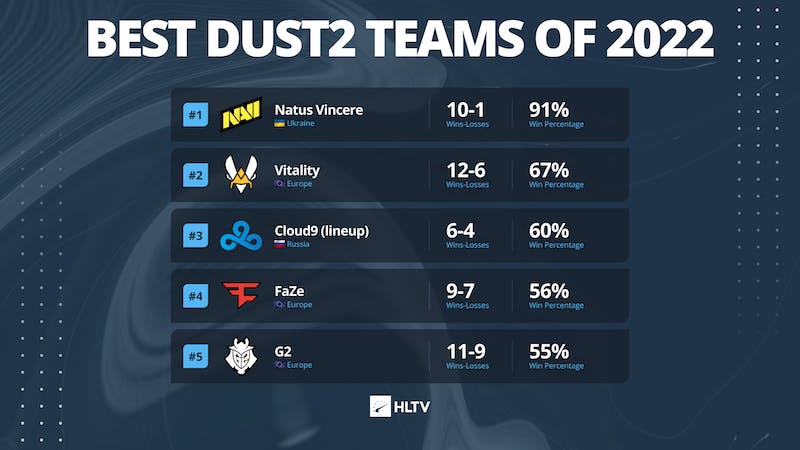
LAN match records on Dust2 in 2022, top 20 filter
CIS superteams Cloud9 and Natus Vincere show the most prowess, which is no surprise given the form Oleksandr “s1mple” Kostyliev and Dmitry “sh1ro” Sokolov have shown on the map. G2 under Rasmus “HooXi” Nielsen and Vitality with Spinx also showed a real knack for Dust2 in the last three months, with Mathieu “ZywOo” Herbaut and Ilya “m0NESY” Osipov key to that. Yet, it was only the true first pick of BIG out of these teams; far more teams permanently banned the map than picked it.
For the rest of the scene, Anubis can be whatever they make it. Our historical data showed that a ‘lucky’ change to the map pool does not always bring success. To truly make the most of the change, teams will have to devote real time and effort either to Anubis or the six other maps that are bound to get less attention for a while. That effort can come about whether they banned Dust2 or not — there is opportunity for everyone, even BIG, to excel on Anubis and make the most out of the swap.
Whatever the case, changes to the pool are good for the game. We can see a team’s mentality by how they play chicken with Anubis in the veto, the way Astralis did with Vertigo in Berlin. There will be new grenades and strategies discovered every day. Valve are sure to update and improve the map in the next few months, too, as more players play it and give them sufficient data to know how to do so.
Some teams and players will bemoan the change and call for a different map’s removal. That would be true whatever map was removed, with most people calling for their own permaban to be removed. Even for the players put at a tangible disadvantage by Dust2’s removal, Anubis is a level playing ground for them to throw their hat into. The teams that will benefit the most from this change are, more likely than not, the ones who will put in the most work. That is undoubtedly a good thing.
[embedded content]
Correction: An earlier version of this article stated that Complexity banned Dust2 in 2022 and ENCE banned Train in 2021, which has now been corrected. Although both teams had played less than 4% of their matches on those maps on LAN, that filter should not have been applied in the years immediately after the pandemic.
- alpha metaverse
- battlebots
- blockchain conference esports
- coin genius
- crypto conference esports
- esport games
- esporta
- esporta app
- esporta fitness
- esports
- Evil Geniuses
- games with esports
- HLTV
- loco esports games
- metaverse esport games
- national sports week
- plato
- plato ai
- plato data intelligence
- plato game
- plato gaming
- platodata
- platogaming
- simplicity esports
- spasm esports games
- steam esports games
- Team SoloMid
- tundra esports
- twitch esports games
- zephyrnet
